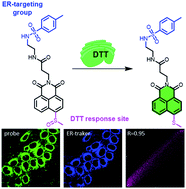The development of an endoplasmic reticulum-targeting fluorescent probe for the imaging of 1,4-dithiothreitol (DTT) in living cells†
Abstract
1,4-Dithiothreitol (DTT) is a robust reducing agent that contributes significantly to the folding process of proteins and maintaining endoplasmic reticulum (ER) homeostasis. Abnormally high levels of DTT can lead to severe endoplasmic reticulum stress (ERS), which induces cell death. In addition, DTT can also hinder cell growth and enhance reactive oxygen species (ROS) production in the ER. Herein, an effective turn-on ER-targeting fluorescent probe, ER-DTT, was designed to image DTT for the first time. The probe ER-DTT was based upon naphthalimide as a fluorophore, p-toluenesulfonamide as an exceptional unit for ER-targeting, and sulfoxide as a response site for imaging DTT based on an intramolecular charge transfer (ICT) mechanism. Optical-response experiments showed that the probe ER-DTT had good selectivity and sensitivity for DTT. Furthermore, confocal microscopy indicated that ER-DTT was suitable for selectively targeting ER in living cells and could be implemented to recognize cellular DTT.

- This article is part of the themed collection: Analytical Methods HOT Articles 2021


 Please wait while we load your content...
Please wait while we load your content...